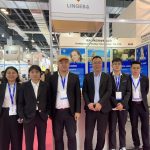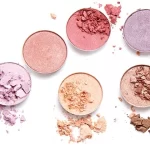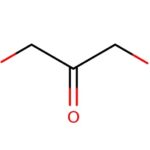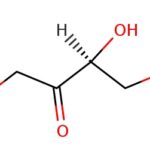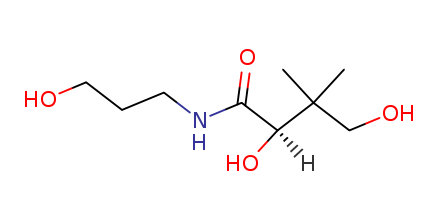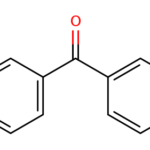Introduction
Potassium azeloyl diglycinate is a colorless or light yellow liquid. It appears in many acne treatment products and formulas and is a derivative of rhododendron acid. As a potassium salt of diamine, it is water-soluble, low in dosage, and has strong anti-inflammatory effects. The control of sebum, skin whitening and skin moisturizing is no less than Azelaic acid. It is also a famous anti acne ingredient. Rhododendron acid has anti acne and whitening properties, and in some cases can treat rosacea. It also has antibacterial and exfoliating properties, suitable for any skin type, and can restore abnormal skin to normal.
Azelaic acid is a traditional whitening and acne removing material, but its application is greatly limited due to its water-insoluble, high melting point, large dosage, easy color change and poor compatibility.Potassium azelaide diglycine is a whitening and acne removing raw material that is soluble in water and used in small amounts. It has good effects in regulating oil secretion and has a strong whitening effect. Numerous experiments have shown that its safety and non irritating properties enable cosmetic formulators to fully utilize its excellent biological effects.
Biological effects
- Suppress skin seborrhea and eliminate skin acne;
- Competitive Sexual inhibition of Tyrosinase activity, with whitening and freckle removing effect;
- Improve skin moisturizing ability and improve skin elasticity.
Preparation method of acne removing and skincare composition
- At room temperature, slowly add glycerol and butanediol into Xanthan gum for wetting, and stir evenly. Add some deionized water, homogenize for 3-5 minutes, and stir for 10-60 minutes to obtain mixture a;
- Heat the remaining amount of deionized water and Curacao vera leaf juice to 50-70 ℃, and dissolve evenly. Add lactic acid, Sodium lactate and sodium gluconate, stir for 5-15min to obtain mixture b;
- Heat mixture b to 80-85 ℃, stir well, and then pump in mixture a. Mix with insulation for 10-30 minutes to obtain mixture c;
- Take Angelica sinensis extract, Salvia miltiorrhiza root extract, Clove flower extract, Scutellaria baicalensis root extract, Glycyrrhiza uralensis root extract, Potassium Azyldiglycine, Caprylsalicylic acid, Caprylglycine, Sophora flavescens root extract, Pyridoxine, and heat at 60-65 ℃ to dissolve evenly. Add it to mixture c through a 200 mesh sieve, and stir at 75-80 ℃ for 30-40 minutes to obtain mixture d;
- The mixture d is cooled to 35-40 ℃, aged for 12-24 hours, and then packaged into a skincare composition with acne removing effects.
Hair growth, hair fixation, and hair care nutrient solution:
Its composition and mass fraction are: SD ethanol 40-B9-15, butanediol 5-10, potassium azelaide diglycine 3-8, purslane extract 5-7, camphor 4-9, Zinc sulfate 3-10, pyridoxine hydrochloride 2-6, panthenol 5-7, saw palmetto extract 4-8, glycerin 6-9, Nicotinamide 4-8, Allantoin 6-9, biotin 3-10, PEG-60 hydrogenated Castor oil 7-9, hydrolyzed yeast protein 3-8, polysorbate 202-6, 6-10 parts of Phenoxyethanol, 1-5 parts of Menthol, 1-3 parts of methyl paraben, 8-13 parts of camellia extract, 11-13 parts of glycyrrhiza glabra root extract, 9-14 parts of propolis extract, 7-15 parts of potassium azelaic diglycine, 5-8 parts of tripeptide-1 copper, 1-3 parts of Tocopherol acetate, 80-100 parts of water.
Formulation and evaluation of the cream made from potassium azeloyl acid diglycinate as an anti-aging: an article from the Journal of Physics about potassium azeloyl diglycinate
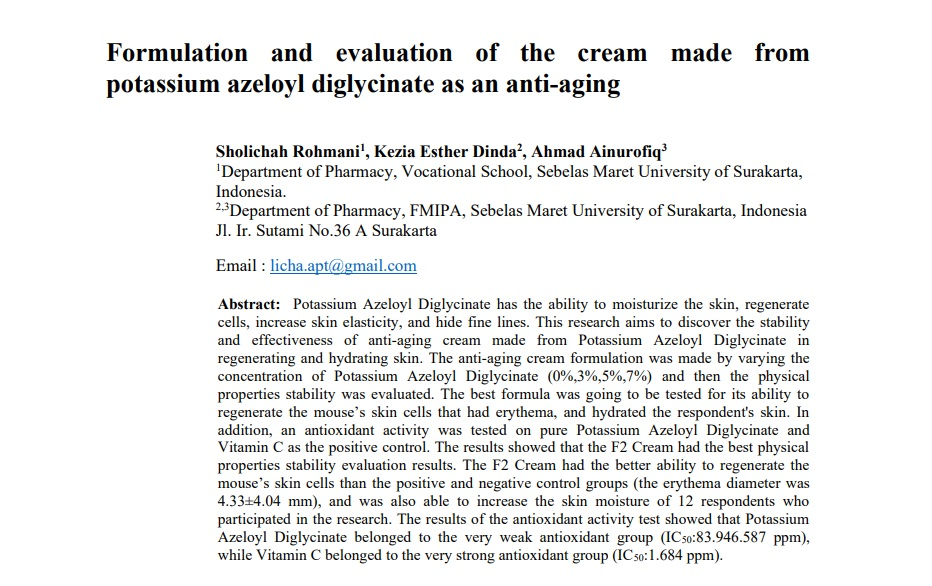
Abstract: Potassium Azeloyl Diglycinate has the ability to moisturize the skin, regenerate cells, increase skin elasticity, and hide fine lines. This research aims to discover the stability and effectiveness of anti-aging cream made from Potassium Azeloyl Diglycinate in regenerating and hydrating skin. The anti-aging cream formulation was made by varying the concentration of Potassium Azeloyl Diglycinate (0%,3%,5%,7%) and then the physical properties stability was evaluated. The best formula was going to be tested for its ability to regenerate the mouse’s skin cells that had erythema, and hydrated the respondent’s skin. In addition, an antioxidant activity was tested on pure Potassium Azeloyl Diglycinate and Vitamin C as the positive control. The results showed that the F2 Cream had the best physical properties stability evaluation results. The F2 Cream had the better ability to regenerate the mouse’s skin cells than the positive and negative control groups (the erythema diameter was 4.33±4.04 mm), and was also able to increase the skin moisture of 12 respondents who participated in the research. The results of the antioxidant activity test showed that Potassium Azeloyl Diglycinate belonged to the very weak antioxidant group (IC50:83.946.587 ppm), while Vitamin C belonged to the very strong antioxidant group (IC50:1.684 ppm).
According to the cited paper, a 1.5% potassium solution of potassium azeloyl diglycinate, applied over 21 days, can reduce oil secretion by 31.5%, increase keratin moisture by 12.7%, and improve skin elasticity by 2.5%. The 21 day skin experiment proved that the experimenter reduced forehead wrinkles by 11.7% and chest wrinkles by 9.4%. Other reports suggest that potassium azeloyl diglycinate has the ability to regenerate inflammatory and pigmented skin cells.
Cell regeneration efficacy ability test via in vivo
The in vivo experiment aims to discover the regenerative ability of potassium azelaic acid glycine anti-aging cream on experimental animal skin cells. In the experiment, the hair of each rat was shaved to a size of 4×4 cm and exposed to UVB light for 72 hours as an inflammatory inducer (erythema). The positive control is product X, and its efficacy will be compared with potassium azelaic acid glycine anti-aging cream. Product X uses Retinol complex as active ingredient, which can remove erythema and regenerate skin cells. The concentration of potassium azelaic diglycine anti-aging cream is 5%, because this concentration has the best physical performance stability test results. In addition, according to Sinerga (2012), the most recommended concentration of potassium azelaic acid in cosmetic formulas is 5%. The negative control group did not receive any treatment. The results of observing cell regeneration ability in vivo are shown in Table 9 and Figure 1.
According to the research, the results showed that the diameter of erythema in all three treatment groups decreased, but the difference lies in the cell regeneration rate and erythema diameter. On the 7th day, the erythema values of the three treatment groups were all 1, but there were differences in the size of the erythema diameter; The negative control group was 21.00 ± 3.61 mm, the positive control group was 17.67 ± 2.52 mm, and the experimental group was 4.33 ± 4.04 mm. Based on these results, it can be concluded that the 5% azelaic acid potassium anti aging cream has the best ability to accelerate the regeneration of rat skin cells. This is because potassium azelaic acid diglycine can alleviate inflammation (erythema) in skin cells. In addition, potassium azelaic acid diglycine also has a moisturizing effect and does not irritate the skin barrier. The statistical analysis result of the erythema diameter on the 7th day in the three treatment groups was p<0.05, indicating a statistically significant difference between the treatment groups.
Hydration test on skin
Apply F2 cream to test its moisturizing ability
From the table, it can be seen that the water and oil content of all mouse skin have increased, so a 5% azelaic acid potassium anti-aging cream can increase skin moisture. The difference in water content increase is influenced by the condition of each tester, such as age, activity time (indoor and outdoor), the amount of water consumed in a day, and the type of skin (normal/sensitive) of the tester. The increased moisture can also slow down wrinkles and make the skin texture smoother. Statistical analysis showed that the water content and oil content were p<0.05, indicating a significant difference in water content between the testers before and after using 5% azelaic acid potassium anti-aging cream.
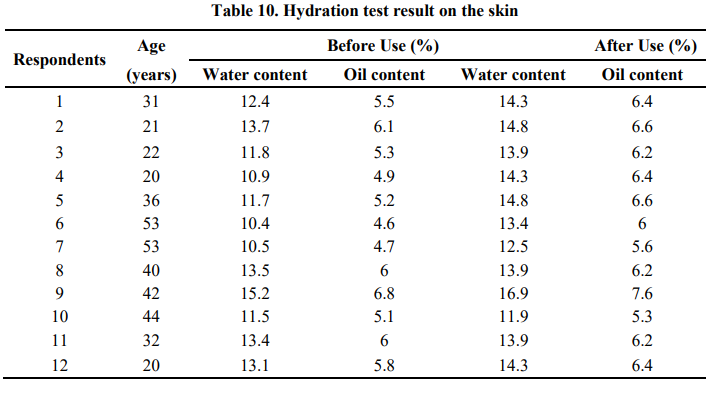
Conclusion
- 5% potassium diglyceride azelaic acid anti-aging cream was formulated with optimal stability and physical properties evaluated according to criteria after 12 days of cycling tests.
- 5% potassium diglyceride azelaic acid anti-aging cream that provides better skin cell regeneration effect on erythema in rats than in positive and negative controls. This is due to the fact that erythema diameter of 4.33 ± 4.04 mm in the test group compared to 17.67 in the positive control group ± 2.52 mm and 21.00 ± 3.61 mm for the negative control. The anti-aging cream also increased the skin moisture of the respondents. This was achieved by increased water and oil content in the 12 respondents who participated in this study.



